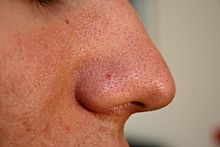Comedo
| Classification according to ICD-10 | |
|---|---|
| L70.0 | Acne vulgaris |
| ICD-10 online (WHO version 2019) | |
A comedo ( plural comedones ; latin comedo .., V lat come particular , eat ', mitessen' consume '), German and blackheads , a is blackish discoloring oily graft, clogging the opening of a sebaceous gland located in the skin. The comedo is the primary efflorescence of acne . In the past, blackheads were known as rhizomes and worms .
A comedo occurs when the channel of the sebaceous follicle due to excessive keratinization, the hyperkeratosis is clogged. Horn lamellae condense into a plug that completely closes the exit of the follicular canal. Due to the stored dye melanin in connection with the oxygen in the air, the closure can turn dark and it oxidizes .
They mainly occur in the T-zone (forehead, nose, chin), and often all over the face in the case of oily skin.
Indicator for comedones is the presence of comedones. These can often persist for months and years, for example during puberty . A distinction is made between open and closed comedones. In closed comedones , the follicle exit is closed, a whitish papule shimmers through, the sebum-horn plug. They tend to become inflamed and festering because the pressure cannot escape to the outside, and a pustule then develops . Since the propensity to ignite is high, it is also referred to as an underlay. The open comedones are yellow and the opening of the follicle is gaping, a black head is visible. This is not dirt, as is often assumed, but a horn lipid plug that has been oxidized by oxygen.
The steatocystoma multiplex must be differentiated from a differential diagnosis .
therapy
Many dermatologists warn against expressing comedones. There is a risk of pushing some of the bacteria deeper into the skin and thus paving the way for the formation of extensive abscesses .
Various manufacturers offer keratolytic clear-up strips to remove comedones . These plaster-like strips are intended to loosen the plugs and completely remove the keratinized skin. In a 1999 test by Öko-Test magazine, the strips performed poorly. In the case of "most [...] not even the flakes that would go away with a simple peeling " were removed, but rather "only a few hairs" were torn out. In addition, the harmlessness of some of the active ingredients it contained was questioned.
Other ways to combat blackheads are products that contain salicylic acid , adapalene and / or benzoyl peroxide . Salicylic acid helps open the pores so the excess sebum can escape from the pores by peeling off the top layer of skin. Adapalene and benzoyl peroxide work similarly.
Another remedy against blackheads are ointments with a high zinc oxide content, as they activate defense and healing processes on the inflamed areas of the skin. Professional treatments by dermatologists and beauticians are usually the most effective. The clogged sebum follicles are opened with a cannula so that the comedones can be broken down by the body's own phagocytes .
Etymology, historical background
The expression blackhead , which appeared for the first time in 1691 in the dictionary Der Teutsche Sprache Genealogy and Fortwachs or Teutscher Sprachschatz by the linguist Kaspar von Stieler , refers to the belief, which was widespread up to the 19th century, that diseases are primarily due to parasites . As a result, comedones were also referred to as parasites , worms or drought maggots , which, like leeches , attach themselves to the body, nest and live on body secretions.
See also
- Epidermoid cyst
- Boils , pustules , abscesses , phlegmon and Bartholin's cyst
- Steatocystoma multiplex
- Comedone lifter
Web links
Individual evidence
- ↑ Alphabetical directory for the ICD-10-WHO Version 2019, Volume 3. German Institute for Medical Documentation and Information (DIMDI), Cologne, 2019, p. 460
- ↑ Komedo bei duden.de , accessed on May 16, 2013.
- ↑ Ludwig August Kraus: Kritisch-Etymologisches medicinisches Lexikon, or explanation of the origin of the Greek, Latin and Oriental. Languages in medicine and in the art expressions initially taken up with it. 3rd, greatly increased and improved edition. Deuerlich & Dieterich, Göttingen 1844, p. 259 .
- ↑ One on the nose . In: Öko-Test , June 7, 1999.
- ↑ A little miracle. ( Memento of the original from September 24, 2011 in the Internet Archive ) Info: The archive link was inserted automatically and has not yet been checked. Please check the original and archive link according to the instructions and then remove this notice. In: Menshealth , March 9, 2006.
- ↑ There is the language worm in there: "Blackheads". Knowing.de , accessed on June 21, 2016.
- ↑ See also the phrase "pull the worms out of someone's nose".



